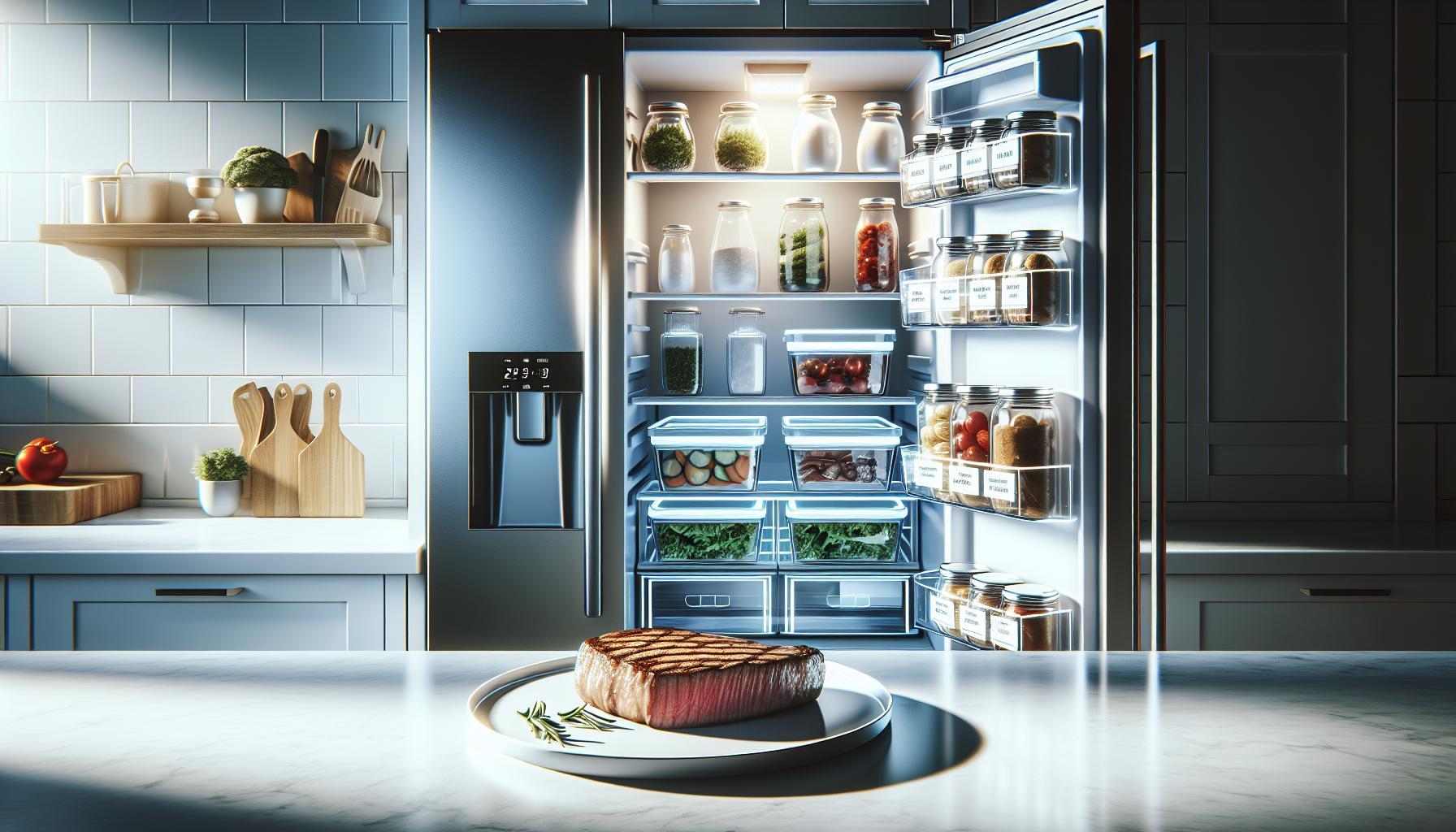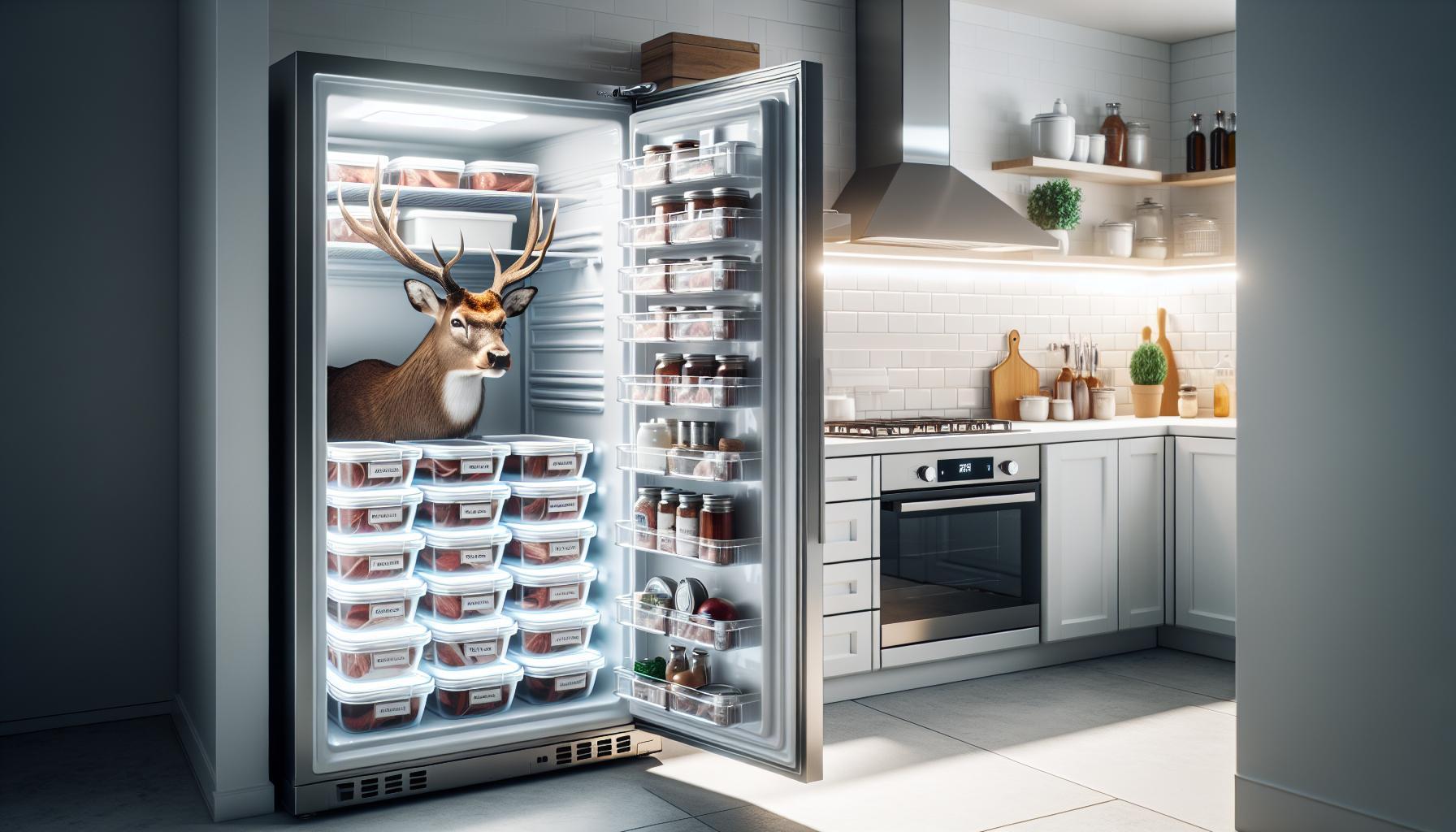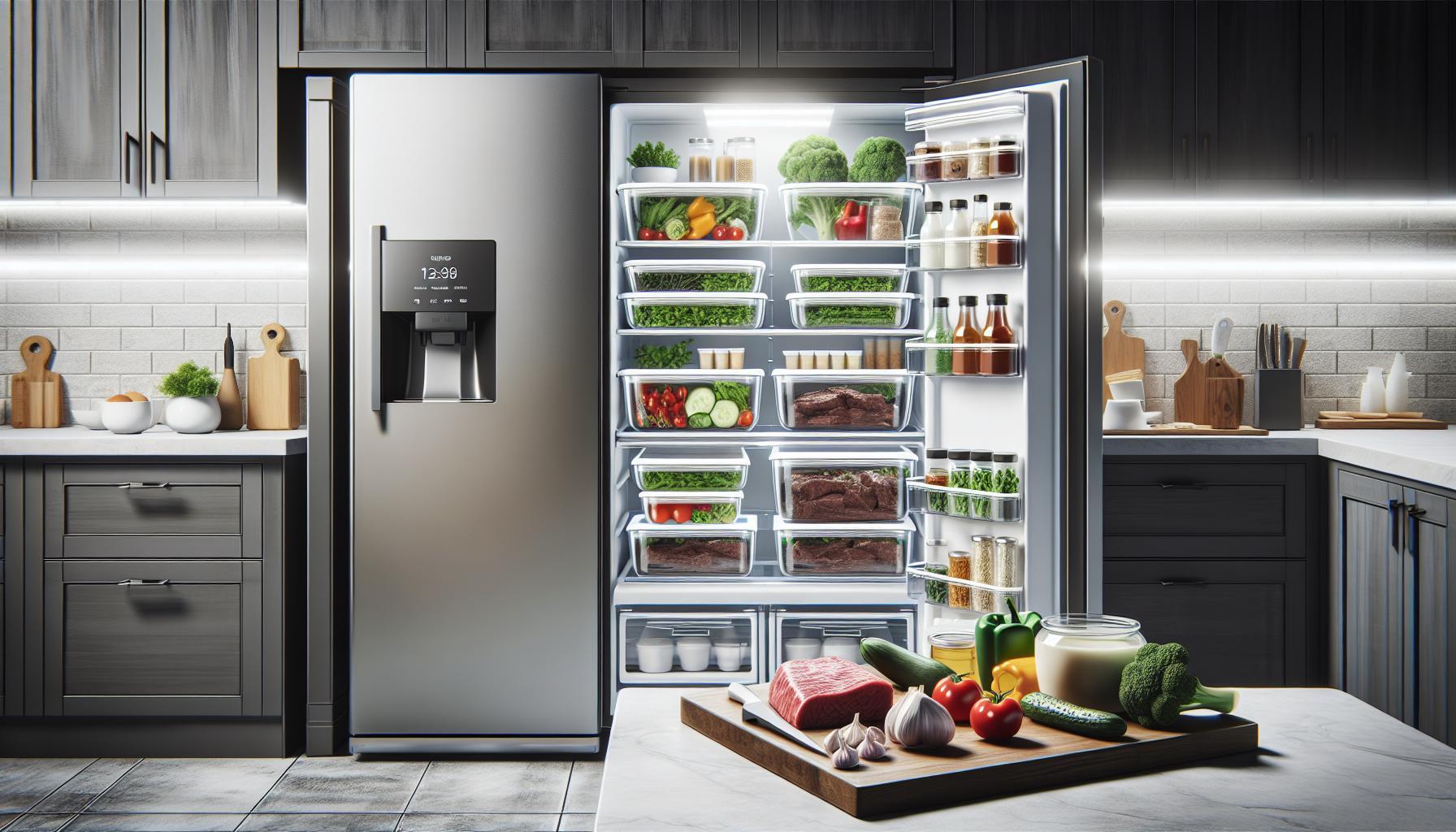When it comes to planning a meal, understanding how long prime rib lasts in the fridge is crucial for both taste and safety. Did you know that improperly stored prime rib can spoil quickly, leading to waste and potential health risks? Knowing the right storage guidelines allows you to enjoy this delicious cut of beef safely, ensuring every bite is as flavorful as the last.
As you savor those tasty leftovers, it’s important to be aware of how long they can stay fresh in your refrigerator. This guide will provide clarity on storage times, ideal temperatures, and signs of spoilage, enabling you to make informed decisions about your meal planning. With practical tips and science-backed information, you’ll feel confident in your food safety practices while enjoying every delicious moment. Keep reading to learn how to savor your prime rib safely and make the most of your culinary creations!
How Long Can Prime Rib Stay Fresh?

One of the most cherished cuts of meat, prime rib can be a centerpiece for festive gatherings and special occasions. Understanding its freshness is crucial for both safety and flavor retention. When stored properly in the refrigerator, raw prime rib can last 3 to 5 days before it starts losing its quality. It’s best kept in its original packaging, ideally placed on a plate to catch any juices that might escape, and stored on the bottom shelf to avoid cross-contamination with other food items.
Once cooked, prime rib has a shorter shelf life-typically lasting up to 3 to 4 days in the fridge. Ensure it is placed in an airtight container or tightly wrapped in aluminum foil to prevent moisture loss and the absorption of odors from other foods. For longer storage, consider freezing. When properly wrapped and sealed in freezer-safe bags or airtight containers, cooked prime rib can maintain its quality for up to 6 months, though consuming it sooner for the best taste is advisable.
By keeping an eye on these timelines and practicing proper storage techniques, you can enjoy your prime rib while it’s at its best, safe in the knowledge that you’re following food safety practices. Always use your senses-look for changes in color, smell, and texture-to determine if your prime rib remains fresh.
Signs Your Prime Rib Has Spoiled
Understanding the signs that indicate prime rib has spoiled is essential for ensuring both safety and quality in your dining experience. Fresh prime rib should have a vibrant, red color, and a firm texture, but as it begins to spoil, several noticeable changes occur.
One of the most alarming signs is a change in color; fresh prime rib typically exhibits a bright red hue. If it transitions to a dull brown or gray shade, this could indicate spoilage. Additionally, spoiled meat often has a slimy or sticky texture which is a clear deviation from the firm feel of fresh cuts.
Another critical indicator is the smell. Fresh prime rib should have a mild, pleasant meat odor. However, if you detect any sour or off-putting smells, it’s time to dispose of it. Lastly, if you notice any excessive liquid pooling in the packaging, it may also suggest the meat has deteriorated.
To enhance your food safety practices, always inspect your prime rib carefully before cooking or consuming it. When in doubt, it’s best to err on the side of caution and discard meat that shows any signs of spoilage. Keeping these visual and olfactory cues in mind will help you enjoy your prime rib safely and deliciously.
Proper Storage Methods for Prime Rib
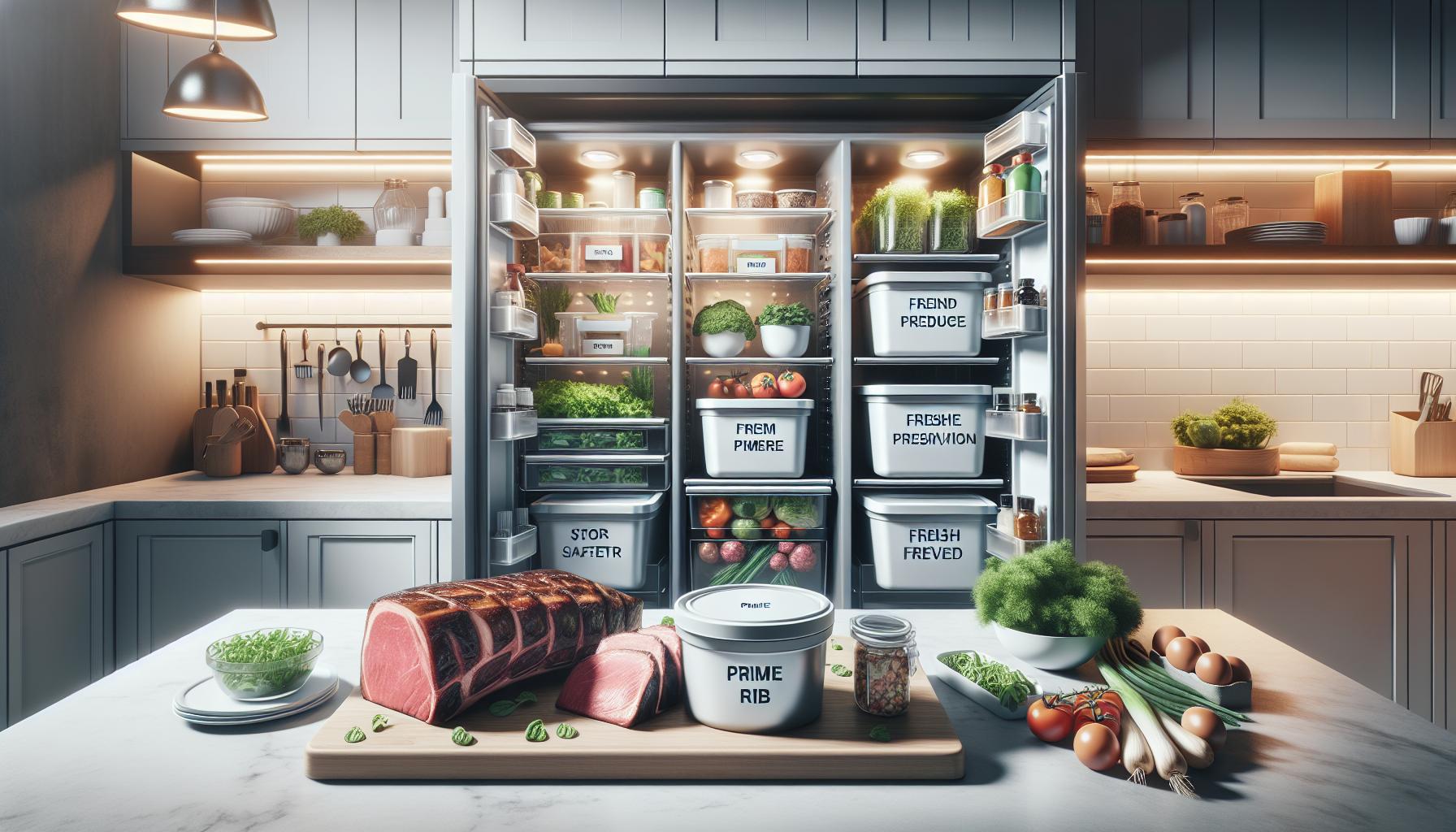
To maximize the freshness and safety of prime rib, proper storage methods are essential. When you bring home prime rib from your local butcher or grocery store, consider how you package and store it to maintain its quality. Fresh prime rib can typically be stored in the refrigerator for up to 3 to 5 days. To ensure it remains at its best during this period, start by keeping it in its original packaging if it’s vacuum-sealed. This helps limit exposure to air and maintains moisture.
For those looking to extend the shelf life further, transferring the prime rib to an airtight container or wrapping it tightly in plastic wrap is highly effective. This minimizes moisture loss and prevents the absorption of odors from other foods. Always place the prime rib in the coldest part of the refrigerator, usually at the back of the bottom shelf, to help keep it at a stable temperature. Maintain your refrigerator temperature at or below 40°F (4°C) for optimal food safety.
If you have any intentions of keeping your prime rib for longer than a week, freezing is the next step. But be sure to freeze it before the expiration of those 3 to 5 days for the best results. Before placing it in the freezer, wrap the prime rib in heavy-duty aluminum foil or freezer paper, or use a vacuum-sealer for the best protection against freezer burn. Properly stored, prime rib can last in the freezer for 4 to 12 months, allowing for delicious meals well beyond its refrigerator shelf life.
When you’re ready to enjoy your prime rib, remember to thaw it safely in the refrigerator, which will help retain both flavor and texture. By employing these proper storage methods, you can ensure that every cut of prime rib you serve remains fresh and enjoyable.
How to Freeze Prime Rib for Longevity
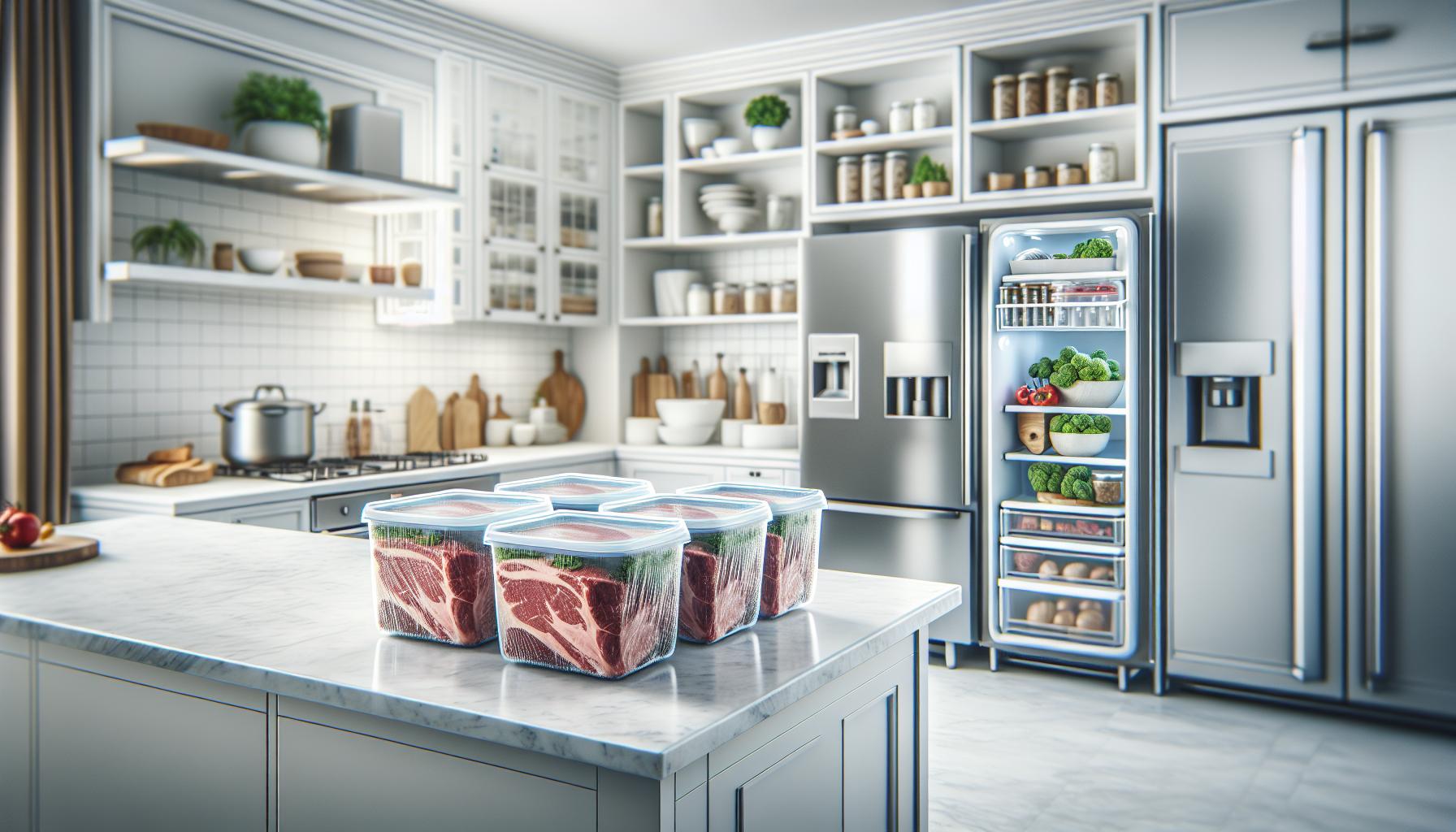
To preserve the quality and flavor of prime rib for future enjoyment, freezing is an excellent option. This method not only extends the shelf life significantly but also maintains the meat’s rich taste and tenderness. Properly frozen prime rib can last anywhere from 4 to 12 months in the freezer, allowing you to savor that delectable cut well beyond its typical refrigerator lifespan.
Start by ensuring that the prime rib is fresh and has not already been kept in the fridge for more than 3 to 5 days. When you’re ready to freeze, wrap the prime rib tightly in heavy-duty aluminum foil or plastic wrap, ensuring there are no exposed areas that could lead to freezer burn. A vacuum sealer is an ideal tool for this task, as it removes air and enhances the preservation of flavor and texture. If using freezer paper, make sure to wrap it tightly and seal all edges well.
Consider labeling each package with the date it was frozen. This practice helps you keep track of how long the meat has been stored. For optimal quality, aim to use the frozen prime rib within 6 months, although it can remain safe to eat beyond that timeframe if stored properly. When it’s time to cook, always thaw it in the refrigerator for best results, as this slow method retains moisture and flavor, setting the stage for a delicious meal.
In summary, freezing prime rib correctly will enable you to enjoy your favorite cut anytime while preserving its quality and taste for months to come.
Reheating Prime Rib Safely
When it comes to savoring leftover prime rib, reheating it safely is crucial to maintain both flavor and safety. The key to enjoying your prime rib without compromising its quality lies in the thawing and reheating process. If you’ve stored your prime rib properly in the fridge (ideally consumed within 3 to 4 days) or frozen it for longer storage, you have options to ensure a delicious return to the table.
Start by thawing your prime rib in the refrigerator if it has been frozen. This method takes time-typically 24 hours for every 5 pounds-but it’s the safest route, maintaining the meat’s texture and taste. Reheating can be done using several safe and effective methods, ensuring that the prime rib reaches an internal temperature of at least 165°F to be safe for consumption.
Oven Method
One of the most effective ways to reheat prime rib is in the oven:
- Preheat your oven to 250°F.
- Place the prime rib in a baking dish and cover it loosely with aluminum foil to retain moisture.
- Heat for about 20 minutes per pound, checking until it reaches the desired temperature.
This method helps keep the meat tender while heating it evenly.
Stovetop Method
Alternatively, you can use the stovetop:
- Slice the prime rib into portions for quicker reheating.
- In a skillet, add a few drops of broth or water and heat over medium-low heat.
- Cover the skillet to create steam that helps warm the meat without drying it out.
Monitor carefully, as this method can heat the meat quickly.
Microwave Method
If you’re short on time, the microwave is also an option, though it requires careful handling:
- Slice the prime rib into smaller pieces and place them in a microwave-safe dish.
- Add a splash of broth or water, cover loosely with microwave-safe plastic wrap.
- Heat in short intervals (about 30 seconds), checking frequently to avoid overcooking.
By following these reheating methods, you can ensure that your prime rib remains flavorful and safe to eat. Remember to always use a food thermometer to confirm that the meat has reached the safe temperature. Savor your leftovers knowing they have been reheated properly and are ready for a satisfying meal.
Delicious Ways to Use Leftover Prime Rib
Leftover prime rib can be a culinary delight, giving you a head start on enticing meals long after your initial feast. With a little creativity, you can transform your prime rib into various dishes that are just as satisfying as the main event. One of the simplest and most indulgent options is crafting a classic prime rib sandwich. Thinly sliced prime rib paired with a savory horseradish sauce and melted provolone on a toasted bun creates a flavorful masterpiece. Add sautéed onions and a side of au jus for dipping, and you’ve elevated leftovers into a delicious meal.
Another way to repurpose your prime rib is by incorporating it into hearty soups or stews. Dice the leftover meat and toss it into a beef broth with vegetables such as carrots, potatoes, and onions. This not only enhances the broth’s flavor with the rich taste of the prime rib but also creates a warming dish perfect for any season. For a slightly different take, consider making prime rib tacos. Shred the meat and warm it in a skillet with some cumin and chili powder, then serve in corn tortillas with fresh toppings like cilantro, diced onions, and avocado for a fresh and zesty option.
If you’re looking for something light yet full of flavor, try preparing a prime rib salad. Slice the leftover meat thinly and serve it atop a bed of mixed greens with roasted vegetables, crumbled blue cheese, and a balsamic vinaigrette. This creates a balanced dish that highlights the delicious flavors of the prime rib while keeping it fresh and exciting.
When using leftover prime rib, ensure you store any unused portions properly. Ideally, enclose it in an airtight container and keep it in the refrigerator, consuming within 3 to 4 days for optimal safety and taste. If you’re planning to save it longer, consider freezing the leftovers, ensuring they are well-wrapped to prevent freezer burn, which can negatively impact flavor. By taking these steps and exploring creative recipes, you can enjoy the full spectrum of flavors that prime rib has to offer long after the main meal is over.
Best Practices for Meal Prep with Prime Rib
When it comes to making the most of your prime rib, meal prep can elevate your dining experience while ensuring food safety. By planning ahead and following best practices, you can enjoy this succulent cut of meat beyond just the initial meal. A well-cooked prime rib can be the cornerstone of various dishes, and with proper handling, it remains safe and delicious for a longer period.
To start, always ensure that your prime rib is stored correctly after cooking. Once it has cooled down, slice it into portions to promote even cooling and freezing. Place the portions in airtight containers or freezer bags, removing as much air as possible to prevent freezer burn. Label each container with the date, as cooked prime rib can generally last about 3 to 4 days in the refrigerator and up to 6 months in the freezer. This approach helps maintain flavor and safety while allowing for quick meal options later.
When reheating prime rib, it’s crucial to do so safely to preserve its tenderness and flavor. Use low heat, either in the oven wrapped in foil or in a skillet with a splash of beef broth, to gently warm it up without drying it out. Aim for an internal temperature of 165°F (74°C) to ensure it’s safe to eat. Additionally, consider distinct dishes that utilize leftover prime rib. Incorporating it into stir-fries, salads, or sandwiches not only provides variety but also maximizes the utilization of this premium cut.
Finally, be mindful of food safety guidelines throughout the process. Keep your preparation area clean and avoid cross-contamination with raw foods. Make certain any leftover prime rib is properly refrigerated within two hours of cooking to minimize bacterial growth. By following these practices, you’ll not only make your meal prep more efficient but also enjoy your prime rib in a variety of delectable ways, all while staying safe and ensuring the best possible quality.
Understanding Prime Rib Shelf Life by Cut
The shelf life of prime rib is influenced by the cut you choose, each offering different qualities and preservation timelines. When you invest in this exquisite cut of beef, understanding its shelf life can help ensure that you enjoy it at its best. Generally, a whole prime rib roast lasts longer than smaller cuts due to the reduced surface area exposed to air, bacteria, and temperature fluctuations.
For whole prime rib roasts, when stored properly in the refrigerator, they can last between 3 to 5 days before needing an immediate cooking approach. Meanwhile, prime rib steaks or individual portions may only be viable for around 3 to 4 days in the fridge once cut. Following cooking, leftover prime rib retains its quality for about 3 to 4 days when refrigerated, making it crucial to label your storage containers with dates to prevent spoilage.
Storage Guidelines by Cut
| Cut of Prime Rib | Refrigerator Shelf Life | Freezer Shelf Life |
|---|---|---|
| Whole Prime Rib Roast | 3 to 5 days | 4 to 6 months |
| Prime Rib Steaks | 3 to 4 days | 4 to 6 months |
| Cooked Prime Rib | 3 to 4 days | 4 to 6 months |
It’s also essential to understand the impact of handling during and after preparation. Prompt cooling and refrigeration are key practices that prevent your prime rib from spoiling. If you’re unsure about the freshness or quality of your prime rib, it’s always safer to rely on your senses: check for any signs of off-odors, discoloration, or an unusual texture before cooking or consuming. Keeping these variations and guidelines in mind will help you savor your prime rib at its peak quality while maintaining safety standards.
Food Safety Guidelines for Cooked Meats
Ensuring food safety, especially for cooked meats like prime rib, is essential to prevent foodborne illnesses and maintain the quality of your meals. Cooked prime rib should be refrigerated within two hours of cooking to minimize bacterial growth. If left at room temperature for more than two hours (or one hour if the temperature exceeds 90°F), it is safer to discard the meat. To keep your cooked prime rib fresh and tasty, store it in airtight containers or tightly wrapped in foil or plastic wrap.
When it comes to shelf life, cooked prime rib can be safely refrigerated for up to 3 to 4 days. Always prioritize proper labeling; noting the packing date on containers helps ensure you consume the meat within this time frame. If you find yourself unable to eat the prime rib within that window, consider freezing it. Properly frozen cooked prime rib can maintain its quality for 4 to 6 months. Just make sure to use freezer-safe packaging to prevent freezer burn, which can affect the texture and flavor.
Before reheating, it’s wise to assess your cooked prime rib for quality. Look for any signs of spoilage, like off-odors, an unusual texture, or discoloration. Reheating should be done thoroughly to an internal temperature of 165°F, regardless of the reheating method (oven, stovetop, or microwave), to ensure safety. Always allow it to cool to room temperature before refrigeration. Following these guidelines will help you enjoy your prime rib without concerns about food safety.
Impact of Marinades and Seasonings on Storage
Using marinades and seasonings can significantly enhance the flavor of prime rib, but they also have implications for storage and shelf life. Marinades, which often contain acidic components like vinegar or citrus juice, can influence the pH of the meat, potentially affecting spoilage rates. On the one hand, acid-based marinades can help inhibit bacterial growth; on the other hand, if not appropriately stored, these flavorful infusions can accelerate spoilage due to the moisture they introduce.
When storing marinated prime rib, it’s essential to ensure it is kept in a sealed container to prevent cross-contamination and limit exposure to air, which can cause oxidation. Use airtight containers or heavy-duty plastic wrap, and label them with the date to keep track of how long they’ve been stored. Generally, marinated prime rib should be consumed within the same 3 to 4 days as unmarinated cooked prime rib, as the added moisture can create a breeding ground for bacteria if left too long. Freezing marinated prime rib is also an option, as it can maintain its quality for up to 4 to 6 months; however, it’s best to freeze it before cooking to preserve the meat’s texture and flavor.
Additionally, the type of seasoning used can have various effects as well. While many seasonings, particularly dry rubs, do not significantly impact storage duration, they can change the meat’s moisture content and fat absorption. Ingredients like garlic and onion powder can add flavor but should be used in moderation; excessive amounts might lead to spoilage even when stored correctly. Overall, the key to maximizing both flavor and safety with marinated prime rib lies in proper storage techniques and awareness of the effects that different ingredients may have. Prioritize safety by refrigerating or freezing promptly, and always inspect marinated meats for signs of spoilage before consumption.
Common Myths About Prime Rib Storage
Food safety is paramount, especially when it comes to storing perishable items like prime rib. Unfortunately, misconceptions can lead to improper handling and consumption of this delicious cut of meat. One prevalent myth is that all cooked meats can remain fresh for a week or more in the fridge, but prime rib, like other cooked meats, should typically be consumed within 3 to 4 days after cooking. This timeframe helps prevent the growth of bacteria that can thrive at refrigerator temperatures.
Another common myth suggests that vacuum-sealed prime rib does not require refrigeration. While vacuum sealing can extend the shelf life of meat by reducing exposure to air, it does not eliminate the need for proper refrigeration. Even vacuum-sealed products should be stored in the fridge and are best consumed or frozen within the recommended timeframes to ensure safety and quality. Additionally, there is a misconception that if prime rib has an off smell or slight discoloration, it can still be eaten after re-cooking. However, any signs of spoilage should not be ignored; consuming spoiled meat can lead to severe foodborne illnesses.
Understanding Storage Duration
Here’s the breakdown of shelf life for cooked prime rib:
| Form of Prime Rib | Storage Duration |
|---|---|
| Cooked Prime Rib (refrigerated) | 3 to 4 days |
| Cooked Prime Rib (frozen) | 4 to 6 months |
| Uncooked Prime Rib (refrigerated) | 3 to 5 days |
| Uncooked Prime Rib (frozen) | 4 to 12 months |
Lastly, many believe that marinating prime rib can preserve it indefinitely. While marinades can help with flavor and inhibit some bacteria, they do not prevent spoilage. The added moisture can actually create a more hospitable environment for bacteria if left for too long. Therefore, understanding these myths and adhering to proper storage guidelines is crucial for enjoying prime rib safely and deliciously. Always err on the side of caution when it comes to food safety, and when in doubt, throw it out!
Tips for Enjoying Prime Rib Beyond the Fridge
There are many delightful ways to savor prime rib beyond just reheating leftovers from the fridge. This flavorful cut of meat can be transformed into a variety of enticing dishes that not only make good use of any leftovers but also keep your meals exciting and diverse. Whether you have planned for some extra servings or are trying to save what’s left after a special occasion, employing creative methods can help reduce waste and enhance your dining experience.
One popular option is to slice leftover prime rib thinly for sandwiches. A prime rib sandwich layered with horseradish sauce and fresh vegetables can be a satisfying meal on its own. For something a bit different, consider making a prime rib stir-fry. Cut the meat into strips and sauté it with a selection of colorful vegetables and a savory sauce. This method not only reinvigorates the flavor of the prime rib but increases its nutritional content with added veggies.
Another fantastic way to enjoy prime rib is by adding it to pasta dishes. Diced leftover prime rib can elevate a simple pasta with garlic and olive oil or be combined with a rich cream sauce. It can also be incorporated into hearty soups or stews, simmering the meat with broth and vegetables to create a comforting dish that warms the soul. When stored properly in the fridge and consumed within a few days, these versatile recipes can make every bite of your prime rib count.
Finally, don’t forget about breakfast! Shred the leftover meat and mix it into scrambled eggs or an omelette, adding in some cheese and herbs for extra flavor. This unique take on breakfast can be both satisfying and a great way to use up extra meat. Remember that while leftovers can provide numerous culinary opportunities, always ensure that the prime rib is within the recommended storage timeframe for safety and quality.
Frequently asked questions
Q: How long does cooked prime rib last in the fridge?
A: Cooked prime rib can last in the fridge for about 3 to 4 days when stored properly in an airtight container. Ensure that it is cooled before refrigerating to maintain quality and prevent bacterial growth.
Q: Can you eat prime rib after 5 days in the fridge?
A: It’s not recommended to eat prime rib after 5 days in the fridge. The USDA advises consuming cooked meats within 3 to 4 days to ensure safety and quality. Always check for signs of spoilage before consuming.
Q: How should I store prime rib in the fridge?
A: To store prime rib in the fridge, wrap it tightly in plastic wrap or aluminum foil, or place it in an airtight container. This helps prevent exposure to air and moisture, which can accelerate spoilage.
Q: What are the signs of spoiled prime rib?
A: Signs of spoiled prime rib include a sour smell, a slimy texture, discoloration, or mold growth. If you notice any of these signs, it’s best to discard the meat to avoid foodborne illness.
Q: Can I freeze prime rib after it has been cooked?
A: Yes, you can freeze cooked prime rib. Wrap it tightly in plastic wrap or foil, then place it in a freezer-safe container. Properly stored, it can last for up to 6 months in the freezer while maintaining quality.
Q: How long does raw prime rib last in the fridge?
A: Raw prime rib can last in the fridge for 3 to 5 days. Store it in its original packaging or wrap it tightly to avoid contamination. Always check the sell-by date for best practices.
Q: Is it safe to reheat prime rib?
A: Yes, it is safe to reheat prime rib. Ensure the meat reaches an internal temperature of 165°F (74°C) when reheating to kill any potential bacteria. Use a meat thermometer for accuracy.
Q: What is the best way to reheat leftover prime rib?
A: The best way to reheat leftover prime rib is to use the oven. Preheat the oven to 250°F (120°C) and place the meat in a baking dish with a splash of broth. Cover with foil and heat until warm to maintain tenderness.
Key Takeaways
To ensure your prime rib remains safe and delicious, remember that properly stored cooked prime rib can last 3 to 4 days in the fridge. If you have any doubts about freshness, it’s better to err on the side of caution and discard it. For more tips on storing and enjoying your meals, check out our guides on safe food storage practices and meal prep essentials. Don’t forget to explore our recipes that make the most of your leftover prime rib!
For expert advice, subscribe to our newsletter for the latest food safety tips and delicious recipes delivered straight to your inbox. Your culinary journey deserves the best, and we’re here to help you savor every moment. Share your thoughts in the comments below or let us know your favorite way to enjoy prime rib!


